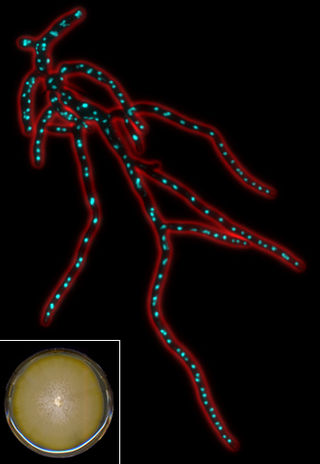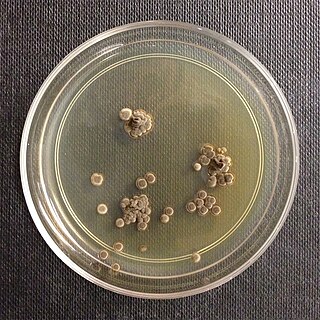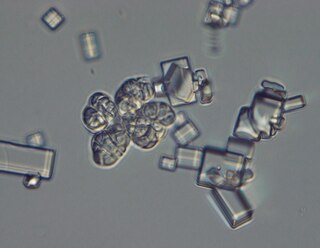Halotolerance is the adaptation of living organisms to conditions of high salinity. Halotolerant species tend to live in areas such as hypersaline lakes, coastal dunes, saline deserts, salt marshes, and inland salt seas and springs. Halophiles are organisms that live in highly saline environments, and require the salinity to survive, while halotolerant organisms can grow under saline conditions, but do not require elevated concentrations of salt for growth. Halophytes are salt-tolerant higher plants. Halotolerant microorganisms are of considerable biotechnological interest.

Pullulanase is a specific kind of glucanase, an amylolytic exoenzyme, that degrades pullulan. It is produced as an extracellular, cell surface-anchored lipoprotein by Gram-negative bacteria of the genus Klebsiella. Type I pullulanases specifically attack α-1,6 linkages, while type II pullulanases are also able to hydrolyse α-1,4 linkages. It is also produced by some other bacteria and archaea. Pullulanase is used as a processing aid in grain processing biotechnology.

Eremothecium gossypii (also known as Ashbya gossypii) is a filamentous fungus or mold closely related to yeast, but growing exclusively in a filamentous way. It was originally isolated from cotton as a pathogen causing stigmatomycosis by Ashby and Nowell in 1926. This disease affects the development of hair cells in cotton bolls and can be transmitted to citrus fruits, which thereupon dry out and collapse (dry rot disease). In the first part of the 20th century, E. gossypii and two other fungi causing stigmatomycosis (Eremothecium coryli, Aureobasidium pullulans) made it virtually impossible to grow cotton in certain regions of the subtropics, causing severe economical losses. Control of the spore-transmitting insects - cotton stainer (Dysdercus suturellus) and Antestiopsis (antestia bugs) - permitted full eradication of infections. E. gossypii was recognized as a natural overproducer of riboflavin (vitamin B2), which protects its spores against ultraviolet light. This made it an interesting organism for industries, where genetically modified strains are still used to produce this vitamin.

Aureobasidium pullulans is a ubiquitous and generalistic black, yeast-like fungus that can be found in different environments. It is well known as a naturally occurring epiphyte or endophyte of a wide range of plant species without causing any symptoms of disease. A. pullulans has a high importance in biotechnology for the production of different enzymes, siderophores and pullulan. Furthermore, A. pullulans is used in biological control of plant diseases, especially storage diseases.

Hortaea werneckii is a species of yeast in the family Teratosphaeriaceae. It is a black yeast that is investigated for its remarkable halotolerance. While the addition of salt to the medium is not required for its cultivation, H. werneckii can grow in close to saturated NaCl solutions. To emphasize this unusually wide adaptability, and to distinguish H. werneckii from other halotolerant fungi, which have lower maximum salinity limits, some authors describe H. werneckii as "extremely halotolerant".

The Wallemiomycetes are a class of fungi in the division Basidiomycota. It consists of the single order Wallemiales, containing the single family Wallemiaceae, which in turn contains the single genus Wallemia. The phylogenetic origin of the lineage was placed to various parts of Basidiomycota, but according to the analysis of a larger dataset it is a sister group of Agaricomycotina. The genus contains species of xerophilic molds that are found worldwide. The seven described species are distinguished by conidial size, xerotolerance, halotolerance, chaotolerance, growth temperature regimes, extracellular enzyme activity profiles, and secondary metabolite patterns. They are typically isolated from low-moisture foods, indoor air dust, salterns and soil. W. sebi is thought to be one of the causes of the hypersensitivity pneumonitis known as the farmer's lung disease, but since the other species were recognised and separated from W. sebi only recently, their role in the disease cannot be excluded.

Exophiala dermatitidis is a thermophilic black yeast, and a member of the Herpotrichiellaceae. While the species is only found at low abundance in nature, metabolically active strains are commonly isolated in saunas, steam baths, and dish washers. Exophiala dermatitidis only rarely causes infection in humans, however cases have been reported around the world. In East Asia, the species has caused lethal brain infections in young and otherwise healthy individuals. The fungus has been known to cause cutaneous and subcutaneous phaeohyphomycosis, and as a lung colonist in people with cystic fibrosis in Europe. In 2002, an outbreak of systemic E. dermatitidis infection occurred in women who had received contaminated steroid injections at North Carolina hospitals.
Black yeasts, sometimes also black fungi, dematiaceous fungi, microcolonial fungi or meristematic fungi is a diverse group of slow-growing microfungi which reproduce mostly asexually. Only few genera reproduce by budding cells, while in others hyphal or meristematic (isodiametric) reproduction is preponderant. Black yeasts share some distinctive characteristics, in particular a dark colouration (melanisation) of their cell wall. Morphological plasticity, incrustation of the cell wall with melanins and presence of other protective substances like carotenoids and mycosporines represent passive physiological adaptations which enable black fungi to be highly resistant against environmental stresses. The term "polyextremotolerance" has been introduced to describe this phenotype, an example of which is the species Aureobasidium pullulans. Presence of 1,8-dihydroxynaphthalene melanin in the cell wall confers to the microfungi their characteristic olivaceous to dark brown/black colour.

Wallemia sebi is a xerophilic fungus of the phylum Basidiomycota.

Wallemia ichthyophaga is one of the three species of fungi in the genus Wallemia, which in turn is the only genus of the class Wallemiomycetes. The phylogenetic origin of the lineage was placed to various parts of Basidiomycota, but according to the analysis of larger datasets it is a (495-million-years-old) sister group of Agaricomycotina. Although initially believed to be asexual, population genomics found evidence of recombination between strains and a mating type locus was identified in all sequenced genomes of the species.
Previously classified under the species complex Aureobasidium pullulans, Aureobasidium subglaciale is a black yeast-like, extremophile, ascomycete fungus that is found in extreme cold habitats. The species was originally isolated from subglacial ice of arctic glaciers. The first isolate of this species was obtained from subglacial ice of the Norwegian island Spitsbergen, one of the coldest places inhabited by humans. of Genomic data collected from specimens in the Aureobasidium pullulans complex justified distinction of four different species
Aureobasidium namibiae, formerly known as Aureobasidium pullulans var. namibiae is a ubiquitous black, yeast-like fungus. It was described on the basis of only one strain isolated from dolomitic marble in Namibia. The species was established when the genomes of the four former varieties of Aureobasidium pullulans were sequenced and the large differences between them were discovered.
Aspergillus olivicola is a species of fungus in the genus Aspergillus. It is from the Nidulantes section. The species was first described in 2008. It has been isolated from fruit in Italy. A. olivicola has been shown to produce aflatoxin B1, emericellin, shamixanthone, siderin, sterigmatocystin, terrein, and varitriol.
Aspergillus stella-maris is a species of fungus in the genus Aspergillus. It is from the Nidulantes section. The species was first described in 2008. A. stella-maris has been reported to produce emericellin and shamixanthone. It has star-shaped ascospores.

Alternaria brassicicola is a fungal necrotrophic plant pathogen that causes black spot disease on a wide range of hosts, particularly in the genus of Brassica, including a number of economically important crops such as cabbage, Chinese cabbage, cauliflower, oilseeds, broccoli and canola. Although mainly known as a significant plant pathogen, it also contributes to various respiratory allergic conditions such as asthma and rhinoconjunctivitis. Despite the presence of mating genes, no sexual reproductive stage has been reported for this fungus. In terms of geography, it is most likely to be found in tropical and sub-tropical regions, but also in places with high rain and humidity such as Poland. It has also been found in Taiwan and Israel. Its main mode of propagation is vegetative. The resulting conidia reside in the soil, air and water. These spores are extremely resilient and can overwinter on crop debris and overwintering herbaceous plants.

Phialophora fastigiata is a mitosporic, saprophytic fungus commonly found in soil, and on wood, and wood-pulp. This species was initially placed in the genus Cadophora but was later transferred to the genus Phialophora based on morphological and growth characteristics. In culture, P. fastigiata produces olive-brown, velvety colonies. The fungus is recognizable microscopically due to the presence of distinctive, funnel-shaped cuffs (collarettes) encircling the tips of phialides that bear slimy conidia. The fungus is often implicated in soft-rot wood decay due to its ability to degrade lignin, cellulose and pectin. It has also been reported to cause blue staining of wood and wood pulp.
Wallemia mellicola is a xerophilic fungus of the phylum Basidiomycota, described in 2015 upon taxonomic revision of the species Wallemia sebi. A large amount of published research referring to W. sebi was likely actually performed on W. mellicola. An example of this is the sequencing of the W. mellicola genome, which was published under the name of W. sebi.
Fungal genomes are among the smallest genomes of eukaryotes. The sizes of fungal genomes range from less than 10 Mbp to hundreds of Mbp. The average genome size is approximately 37 Mbp in Ascomycota, 47 Mbp in Basidiomycota and 75 Mbp in Oomycota. The sizes and gene numbers of the smallest genomes of free-living fungi such as those of Wallemia ichthyophaga, Wallemia mellicola or Malassezia restricta are comparable to bacterial genomes. The genome of the extensively researched yeast Saccharomyces cerevisiae contains approximately 12 Mbp and was the first completely sequenced eukaryotic genome. Due to their compact size fungal genomes can be sequenced with less resources than most other eukaryotic genomes and are thus important models for research. Some fungi exist as stable haploid, diploid, or polyploid cells, others change ploidy in response to environmental conditions and aneuploidy is also observed in novel environments or during periods of stress.

Aureobasidium is a genus of fungi belonging to the family Dothioraceae.








